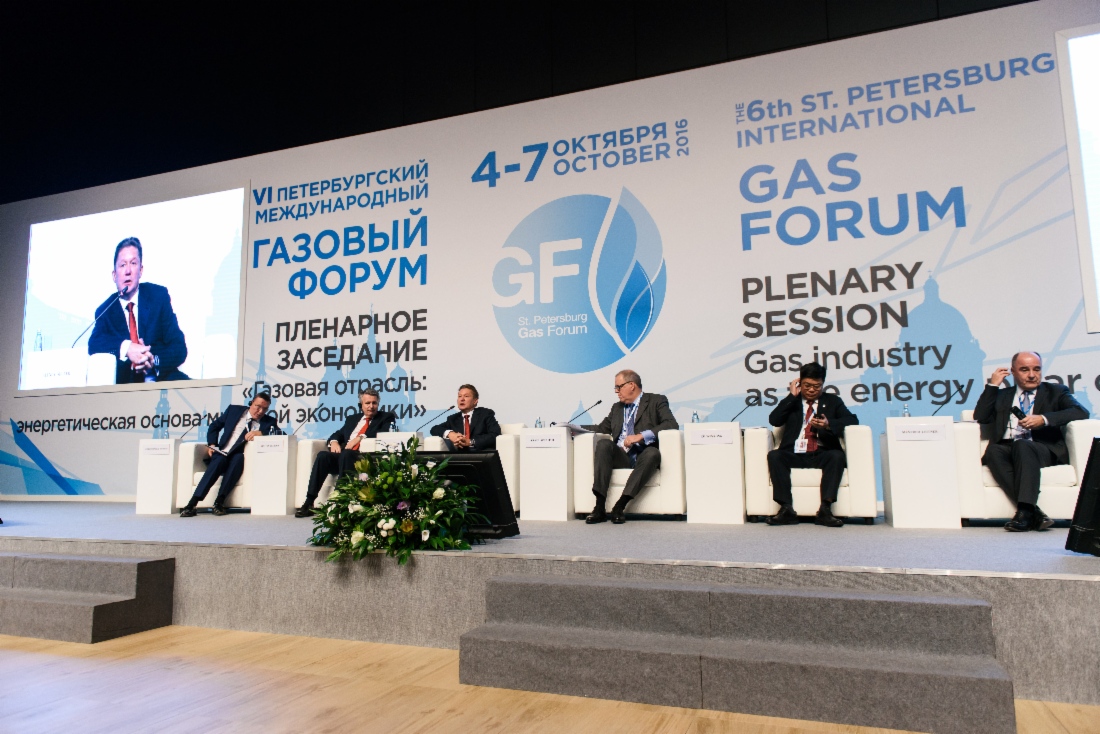Speech by Alexey Miller at St. Petersburg International Gas Forum
In my speech I would like to address the role of gas in ensuring sustainable development of the world economy in the long term. There are a number of problems and challenges facing the world economy that cannot be tackled without gas, without raising its share in the global energy mix and boosting its consumption rates worldwide.
The first challenge is growing energy consumption due to the steadily increasing population of the planet. At present, the Earth’s population is 7.3 billion. Some 30 years from now, by the middle of the 21st century, there will be a total of 10 billion people. Without a doubt, the world gross domestic product will continue to rise and it means that economic growth is energy consumption growth. What resources and what fields will cover this mounting demand?
Another challenge facing the world economy is that the main economically advanced countries are lacking their own energy resources. If we look at the developed countries, at the major world economies, we will see that absolutely all of them are net gas importers: Germany, France, Italy, the UK, the USA, China, Japan, South Korea, and India. India has been deliberately last named. Among the countries listed above, India is increasingly establishing itself in these days as one of the fastest growing economies. Over the past 10 years, the share of gas imports in India’s energy mix has increased 1.5-fold. Gazprom will therefore have a strong focus on the Indian market in the very near future.
We are also fully aware that another challenge for the world economy is the need to mitigate environmental impacts. Undoubtedly, natural gas has enormous competitive advantages over other energy sources in this area. CO2 emissions from natural gas are 1.8 times lower than those from gas oil and diesel and over 2 times lower compared to coal.
What are the primary grounds for saying that all those problems and challenges to be faced by the world economy in the medium term will be solved by gas? The answer is immense gas resources available around the globe. In the near future, we will witness a steady growth of international gas trade. According to our estimate, over the next 25 years the average consumption growth rate for gas will annually be 3.5 times higher than that for liquefied hydrocarbons and coal worldwide. In just 15 years, global gas consumption will increase by 30 per cent. Let me remind you that today the world consumes some 3.5 trillion cubic meters of gas per year.
It should be noted here that compared to absolutely all other energy commodities natural gas is the only energy commodity that has not realized its potential for market globalization until now. The gas market globalization has already begun, though only across major local and regional gas markets so far. As an energy commodity, gas has yet to take a big competitive step forward owing to its potential for globalization.
I can say that my colleagues, who are present here today and who are partners of Gazprom, will definitely contribute to the globalization of the world gas market. The companies, whose top executives are here today, have global energy strategies. The global gas market hasn’t been shaped yet, but the companies have already developed their global energy strategies.
The companies are already discussing those strategies at their bilateral meetings. Such discussions will also be held during this Forum, including with regard to specific projects aimed at facilitating the gas market globalization. Undoubtedly, the globalization requires the construction of new infrastructure, namely new gas transmission infrastructure. Gazprom has made a lot of effort to that end. Our projects in the north and in the south are well known to all of you. It should be noted here in the first place that energy consumers, namely gas consumers, should welcome that producers, particularly Gazprom, have invested heavily to ensure natural gas supplies to consumers.
Let us look at Germany – our largest market in Europe, and consider its current state, and let us also look at China – the most promising and the most extensive market in the world.
We have been operating in the German market for over 40 years. Germany is heading the list of the biggest gas consumers. But I would like to draw your attention to the fact that just recently the growth rates of Russian gas supplies to the German market have increased significantly. 2015 was a record breaking year: Germany purchased 45.3 billion cubic meters of gas from Russia, exceeding the 2014 result by over 17 per cent. This trend continues in 2016. Within the nine months of this year, Gazprom’s gas exports to Germany have risen by 1.9 billion cubic meters in absolute figures. What does it mean? It means that a record high amount was reached in 2015, but 2016 will surpass it. A new record will be set this year and Germany will remain an undisputed leader in terms of consumption of our gas that we export to Europe.
At the same time it should be noted that in 2016 gas – gas, I would like to emphasize it – is showing the highest consumption rates in the German market. Over the first six months, total gas consumption in Germany has grown by 6.8 per cent. It is very important to compare this figure with the growth rate for renewable energy sources as Germany is rapidly developing this segment. However, in 2016 it has declined twice as much compared to the gas demand growth, not to mention the fact that natural gas is definitely gaining an advantage over coal in the German market.
Let us take a look at the Chinese market. We entered into a very big contract to supply China with natural gas from Eastern Siberia. Today we are running the Power of Siberia project stipulating 38 billion cubic meters of annual supplies for a period of 30 years. It is the largest contract for Gazprom. When signing the contract, we pointed out that Germany had been moving towards such gas amount for 40 years, while China obtained it within one day by signing that contract.
Let us look into the potential of the Chinese market. First of all, it should be pointed out that the share of gas in the Chinese energy mix is four times lower than the global average. It is four times lower, even though gas consumption is tremendously high in China today!
What are the prospects? Leaving aside any timelines, I will just focus on the structure of the energy mix and its specific indicators. The main sectors for gas consumption growth in China are power and heat generation, household, industrial and commercial sectors, and transport.
The power industry: if we assume that the level of gas-fired power generation in China reaches one third of the energy mix, the country will need 330 billion cubic meters of extra gas every year. If we look at the specific indicators of gas consumption in the household and commercial sectors (by the commercial sector we mean foodservice, trade, offices) and suppose that China is going to bring the average specific indicators of consumption in these two sectors to the same level with Germany, it will require around 550 billion cubic meters of extra gas a year. Please note that we are already talking about some trillion cubic meters without the industrial sector, transport, and heat generation.
The point here is not to give any concrete figure demonstrating potential consumption growth in China in the medium or long term. It is all about a very broad and receptive market. There is no doubt that as a developed country, China will also address the problems and challenges of the world economy with the help of gas. As gas will be key to resolving all those global issues.
Today’s world gas reserves are sufficient for fully meeting the growing gas demand in the 21st century. However, in 2014–2016 the amount of investments made by the global oil and gas industry in field development has fallen by 25 per cent. As a result, the number of new discoveries has dropped in 2016 to an all-time low in the comprehensive history.
What is the conclusion? The conclusion is as follows: the current level of global energy prices makes it impossible to tackle those tasks of the global economy that can be solved only with the help of gas. It means that in the very near future we will definitely witness an upward trend of energy price growth around the world. Otherwise, I would like to highlight it, the crucial problems and challenges of the world economy could not be solved. There are no ways of dealing with them without natural gas.
Thank you for your attention.






